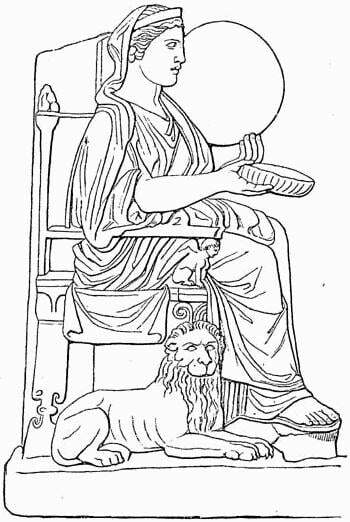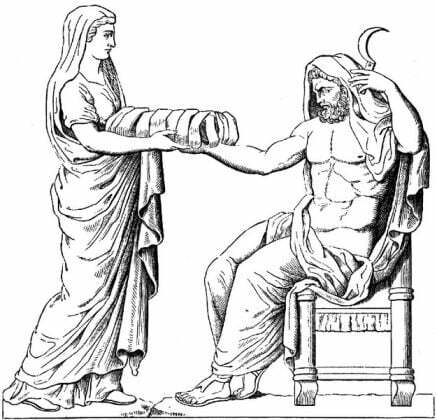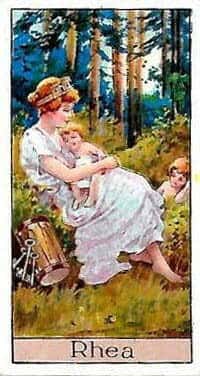Rhea (also known as Rheia) was one of the original Titans, born from the alliance of Gaia (Earth) and Uranus (Sky). Like her mother Gaia, Rhea personified the Earth and was the goddess of fertility and motherhood.
She belonged to the second dynasty of Greek gods and goddesses and was the sister and wife of Cronus, the God of Time and Destruction, and became the mother to an entire constellation of Olympian gods.
Key facts
- Rhea was the sister and wife of Cronus, the god of Time and Destruction. They became rulers of the gods after Cronus overthrew and castrated their father Uranus. Other Titans became their court.
- Rhea gave birth to five children each of whom Cronus swallowed immediately after birth. Gaia and Uranus had made a prophecy that he was going to be overthrown by one of his own children and Cronus wanted to prevent that. Luckily, Rhea managed to hide her sixth child, Zeus, from his tyrant father. Eventually, Zeus managed to overthrow Cronus and rescued his siblings.
- Rhea played a part in the Titanomachy, a 10-year war between the Olympian gods and the Titans. Upon winning, the Olympians banished the Titans to Tartarus. Rhea, however, was spared and resided on Mount Olympus with her children.
Origins

Rhea was the daughter of Gaia, the primordial goddess of the earth, and Uranus, the primordial god of the sky. She was one of the original titans and sister of Cronus, who also became her husband. When Cronus dethroned Uranus as the ruler of the universe. Some myths state that Uranos was also castrated by Cronus – a gesture that symbolized the split between the Sky and the Earth. Cronus went on to marry his sister Rhea, which might sound strange but is not uncommon in Greek myths! Rhea then became the queen of the universe by his side, but not for long.
Although not as prominent as her son Zeus or her grandchildren Apollo or Athena, Rhea holds an important place in Greek religion and mythology. With the powers allowing her to assist in delivering babies and raising children, induce a sense of tranquility and ease mental illness, she is regarded as the symbol of motherhood.
Once the Olympian gods rose to power, Rhea became a minor figure on Mount Olympus. However, she continued to have a role even when reduced to the role of a minor goddess on Mount Olympus, which is reflected in the myths about Rhea, the Mother of Gods.
Name and epithets
- Rhea is also referred to as Rheia
- The name Rhea means “flow” and “ease”
- Rhea is also referred to as Meter Megale or The Great Mother, and Meter Theon or Mother of Gods. Another, less common, name for her was Meter Oreie, or Mountain Mother.
- Interestingly, the names of goddesses Rhea and Hera are anagrams of one another.
Family tree
Rhea was the daughter of Gaia, goddess of earth and mother of all life, and Gaia’s son Uranus, the god of the Sky. She was one of the Titans and the wife of the youngest Titan, her brother Cronus (leader of Titans). She had 6 children: Hestia, the virgin goddess of the hearth, Hades, Demeter, Poseidon, Hera and Zeus. Her grandchildren that are mentioned by ancient authors are Athena, the goddess of wisdom, Eres, Ares, the god of war, Hephaestus, the god of blacksmiths, Apollo, Artemis, goddess of the hunt and Here through Zeus, as well as A Horse (name unknown) and Poseidon’s Son (name unknown) through Poseidon.
Domains of power
Rhea is an extremely powerful goddess. However, her powers are not about combat. Rather, the opposite. She is the goddess of fertility and motherhood who assists in the delivery of babies and in raising children. Titaness Rhea is also known for her ability to bring serenity through her very presence and induce a powerful sensation of tranquility. Her gift of mental healing is associated with this power.
In fact, Rhea’s power of inducing serenity did not end with her but was inherited by her daughter Hestia. Although motherly and tranquil, Rhea is not always in a good mood. There are several myths that mention occasions when the goddess was angered. According to these myths, Rhea’s fury was terrifying.
Symbolism
Rhea is often depicted holding a stone wrapped in swaddling clothes or passing the stone to Cronus. There are also depictions of her on the chariot, or on the throne, sometimes flanked by two lions or lionesses.
Just like the Anatolian goddess Cybele with whom she is closely associated, she is often depicted as a matronly woman in a turret-shaped crown, often guarded by two lions.
Classical literature on Rhea
- Rhea only appears in Greek art from the 4th century BC onwards. As her gradual merging with Cybele was taking place during that period, their names are interchangeable in Greek mythology and in literature.
- Homer makes only a passing allusion to Rhea.
- Hesiod left the most ancient account about her.
“But Rhea was subject in love to Cronos and bore splendid children, Hestia, Demeter, and gold-shod Hera and strong Hades, pitiless in heart, who dwells under the earth, and the loud-crashing Earth-Shaker, and wise Zeus, father of gods and men, by whose thunder the wide earth is shaken”.
- In Argonautica by Apollonius of Rhodes, she is referred to as Mother ruling the winds, the ocean, and the whole earth.
“On the following night they passed the isle of Philyra, where Cronos, son of Uranus, lay with Philyra, having deceived Rhea, when he ruled the Titans on Olympus, and that other, Zeus, was yet being reared in a cave in Crete by the Idaean Curetes; but the goddess caught them in the midst of their dalliance; and he sprang up and sped away in the semblance of a horse with flowing mane”
[Argonautica, Book II]
Place in ancient Greek religion
This ancient, pre-Hellenic goddess was worshiped sporadically throughout the Greek world. However, the original and main place of her worship was on the island of Crete, where, according to the myth, she gave birth to Zeus in the sacred cave on Mount Ida and where Zeus was brought up by Curetes.
However, temples dedicated to her were found all over ancient Greece. Several of them were dedicated to Rhea under the name of Meter Theon (Mother of the Gods). The ones in Attika, Arkadia, by the Acropolis of ancient Corinth, and in Athens were mentioned by Greek traveler and geographer Pausanias.
There was a sanctuary for Meter Megale (The Great Mother) in Sparta. In Olympia, there was both an altar and a temple dedicated to Meter Theon. Rhea (Meter Theon)’s temple in Akriai, Lakedaimon is her oldest sanctuary in the Peloponnese.
Starting from the 4th century BC, Rhea gradually blended with the old Anatolian mother-goddess Cybele, to the point that their names were used interchangeably in both Greek literature and in worship. They were depicted with the same attributes: the throne or chariot, the turret crown, lions or lionesses, and a stone in swaddling clothes.
Worshiping of Rhea was accompanied by the beating of special tympanon drums, cymbals, and blowing horns. Rhea’s priests Corybantes chanted and performed orgiastic dances in the forest and on the mountains.
Stories where Rhea plays a part

Rhea, Cronus, and Philyra
On the days when Cronus ruled the Titans together with his consort Rhea, Rhea once surprised him in the act with Oceanid Philyra. Cronus then galloped off in the form of a long-maned stallion. As for Philyra, she gave birth to Chiron, The Wise Centaur.
Rhea, Cronus and Zeus
Gaia and Uranus warned Cronus that just as he had overthrown his own father, he would one day be overcome by his own child. Bloodthirsty Cronus then devoured his own children immediately after Rhea gave birth to them.
This was his way to make sure the prophecy was never fulfilled. Rhea appealed to her parents Uranus and Gaia for help to save her sixth child, Zeus. On their advice, she brought Cronus a stone wrapped in swaddling clothes, which he promptly swallowed.
Supported by his grandmother Gaia, Zeus grew up in a cave in Crete, where the sacred goat Amalthea nurtured him (later Amalthea was made immortal by Zeus), and guarded by Rhea’s golden dog. Nymphs called Melissae fed him with honey while doves brought him nectar and ambrosia.
Rhea appointed the Curetes (Dactyls) – gods or spirits of the wild mountainside to guard the baby Zeus in the cave on mountain Ida in Crete. The Curetes constantly made noise and drowned the baby’s cries in the clatter by clashing spears and shields during their frenzied dance.
When Zeus grew up, he used the potion given to him by his grandmother Gaia to make Cronus spit out whatever he had swallowed. Cronus disgorged everything in the reverse order: first came the stone, which was later placed in Delphi as a relic, and then Zeus’s brothers and sisters.
Titanomachy followed, i.e., the long war between the Titans and the Olympians. Zeus and other Olympians won it with help from the Hecatoncheires, The Hundred-Handed Giants and the Cyclops. Many of the Titans were confined in the Tartar as a result. According to some of the ancient authors, Zeus castrated his father Cronus just as Cronus had castrated Uranus.
Rhea cures her grandson Dionysus from madness inflicted by Hera
Zeus fell in love with a mortal, the Princess Semele of Thebes, and conceived a child with her. His wife, goddess Hera, was very jealous and tricked the pregnant Semele into asking Zeus to appear in front of her in his full glory. Zeus did not have a choice as he was bound by an oath.
When he did what Semele had asked, the princess was struck by his lightning-bolt and died in a blaze. Zeus recovered his unborn son from her body and sewed him into his thigh which allowed him to carry the baby to term.
As the boy Dionysus, the god of wine and revelry was growing up, disguised as a girl, with Semele’s sister Ino, Hera learned about his existence and whereabouts. She drove Ino and her husband mad so they killed both their children and themselves. Ino jumped into the sea and drowned, but turned into the goddess Leucothea.
When Hera realized that she had failed to kill Dionysus, she had the Titans attack him and tear him to shreds. Dionysus’s grandmother Rhea rescued some of his parts and brought him back to life. Mountain Nymphs, Guardians of Nature, Rhea’s assistants, looked after her grandson.
When Hera discovered that Dionysus was still alive, she inflicted on him a particular kind of madness that caused him to wander the world without a purpose. Fortunately for the young Dionysus, his grandmother saved him once again, helping him to regain his sanity.
Rhea and Atys
Stories in which goddess Rhea shows her temper are not many. However, they are a great illustration of how terrifying the goddess could be in her anger.
When Rhea fell in love with youth of remarkable beauty, Atys son of the river nymph Saggarious, she soon discovered that Atys was not faithful to her and committed to marrying a daughter of a king in Pessinos. Atys was in the middle of a wedding feast with his new passion when the furious goddess burst upon the wedding party. Guests were seized with panic, and Atys, afflicted with temporary madness, fled to the mountains and destroyed himself.
Rhea was so moved with sorrow and regret that she established yearly mourning for Atys. To mourn him, her priests, the Corybantes, marched into the mountains to search for the lost youth. The search was accompanied by the Corybantes’ usual attributes: the beating of drums and shields and the chanting.
Hippomenes and Atalanta
Hippomenes fell in love with the mighty huntress Atalanta but the huntress declared that she could only marry a man who would beat her in a race. Knowing that he could never win unless helped by the goddess of love Aphrodite, the goddess of love, Hippomenes prayed to her.
The goddess helped by giving him three irresistible golden apples. Hippomenes threw them one by one in front of Atalanta during the race. The apples distracted the huntress and she was not able to catch up with Hippomenes.
Once they were happily married, Hippomenes started to forget to thank Aphrodite in his prayers. The offended goddess decided to punish both him and his wife. Once when they were passing a temple of Rhea, Aphrodite inflicted them with such a great desire for each other that they couldn’t resist going inside the temple to make love.
This angered Rhea so much that she turned them into lions. This was done to keep them away from each other forever, as the ancient Greeks thought that lions could not mate with each other, but only with leopards.
Depictions in Art and Pop Culture
In Greek Art
- Rhea is a little-known goddess, and depictions of her are not that abundant. From the 4th century BC, she is indistinguishable from Cybele. Rhea-Cybele is depicted in paintings, bas-reliefs and sculptures and vases. She is usually depicted as handing a rock to Cronus. Sometimes however also riding a lion (as in the fascinating painting which is part of the Pergamon alter). Sculptures depict her seated on the throne in a turret-like crown, often guarded by lions on two sides.
- The legendary Athenian sculptor Phidias made a statue of Rhea that was worshipped in the district of Kerameikos in Athens.
In Pop Culture
- Rhea appears in the game God of War II (2007). She is shown in a flashback and is saving her son Zeus from being devoured by her husband Cronus.
- Rhea is humorously mentioned in Percy Jackson & The Olympians: The Lightning Thief (novel by Rick Riordan) as the mother of Zeus and Poseidon and the subject of their frequent clashes.
- Rhea is mentioned in the short story The Diary of Luke Castellan (also in connection with preventing baby Zeus from being swallowed by his father Cronus).
Frequently Asked Questions
Rhea (Rheia), one of the Titans, was the mother of gods and goddess of female fertility, motherhood and generation.
Rhea is famous as the brave mother goddess who tricked her husband, the terrible Titan Cronus, by giving him a stone to swallow instead of their son Zeus. She was worshipped as the goddess of female fertility and childbirth as well as the mother of all gods.
Titaness Rhea belongs to the ancient Greek religion and Greek mythology.
Rhea was thought to improve fertility and assist women in childbirth and raising children. Myths that mention her create an impression of the goddess-mother who is willing to help her children and grandchildren. However, if she was made angry, her fury was terrifying.
Her stone is moss agate, her sacred animal is lion, her day is Saturday, and her planet is Saturn.
Rhea, daughter of Gaia, the Earth and Uranus, the god of the Sky, was the mother to the younger generation of gods, the Olympians.
Featured Image Creditt: Via Wikimedia Commons

